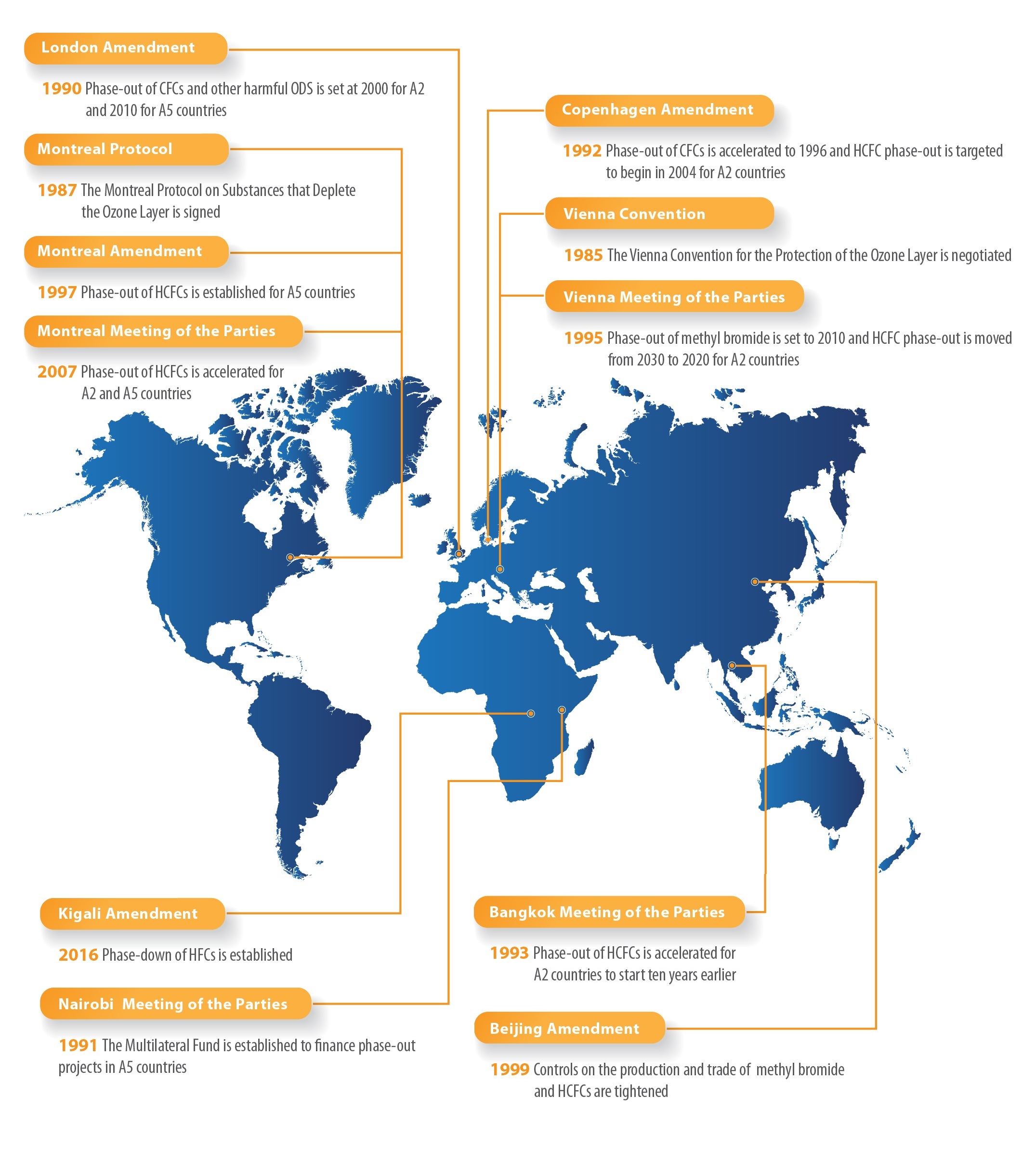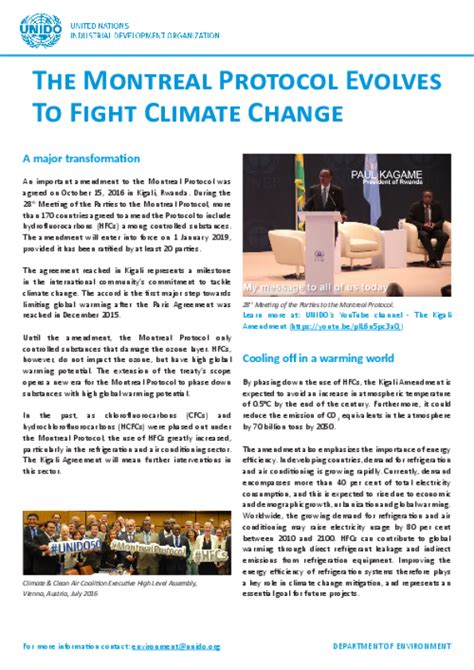Montreal Protocol

The Montreal Protocol, officially known as the Montreal Protocol on Substances that Deplete the Ozone Layer, is an international treaty signed in 1987 that aimed to protect the Earth's ozone layer by phasing out the production and consumption of ozone-depleting substances (ODS). This landmark agreement has had a profound impact on the environment and has set a precedent for global environmental cooperation.
A Historic Agreement: The Montreal Protocol

In the late 1970s, scientists discovered that certain chemicals, including chlorofluorocarbons (CFCs) and halons, were responsible for the depletion of the ozone layer, a protective shield in the Earth's stratosphere that absorbs harmful ultraviolet (UV) radiation from the sun. This discovery raised serious concerns about the potential health and environmental consequences, leading to the urgent need for global action.
The Montreal Protocol, named after the city where it was signed, marked a significant milestone in international environmental law. It recognized the severity of the ozone depletion issue and the collective responsibility of nations to address it. The treaty's primary objective was to control and ultimately eliminate the production and use of ODS, thereby allowing the ozone layer to recover and protect life on Earth from excessive UV radiation.
Key Provisions and Timeline
The Montreal Protocol outlined a comprehensive plan to phase out ODS, with specific timelines and targets for different substances. Here are some of the key provisions and milestones:
- CFC Phase-out: The protocol mandated a complete phase-out of CFCs, the most widely used ODS at the time. Developed countries committed to freezing production at 1986 levels by 1989 and reducing production by 50% by 1998. Developing countries were given a grace period, with a freeze scheduled for 1995 and a 50% reduction by 2007.
- Halon Control: Halons, another major ODS, were controlled under the protocol. Developed countries agreed to freeze production at 1986 levels in 1992, while developing countries had a grace period until 1995.
- HCFC Phase-down: Hydrochlorofluorocarbons (HCFCs) were considered transitional substitutes for CFCs, but they still had some ozone-depleting potential. The protocol established a phase-down schedule, with developed countries reducing production and consumption by 35% in 2004 and by 100% by 2030. Developing countries were given a longer phase-out period, with a freeze scheduled for 2016 and a 100% reduction by 2040.
- Alternative Technologies: The Montreal Protocol encouraged the development and adoption of environmentally friendly alternatives to ODS. It provided financial and technical assistance to help countries transition to ozone-friendly technologies, such as hydrofluorocarbons (HFCs) and other non-ODS substances.
- Scientific Assessment: The protocol established a rigorous scientific assessment process to monitor the state of the ozone layer and the effectiveness of the measures taken. Regular assessments are conducted to evaluate the latest scientific data and adjust the treaty's provisions if necessary.
| Substance | Phase-out Timeline |
|---|---|
| CFCs | Complete phase-out by 1996 (developed countries) and 2010 (developing countries) |
| Halons | Complete phase-out by 1994 (developed countries) and 2010 (developing countries) |
| HCFCs | 100% reduction by 2030 (developed countries) and 2040 (developing countries) |

The Success Story: Ozone Layer Recovery
The Montreal Protocol has been hailed as one of the most successful international environmental agreements to date. Its impact on the recovery of the ozone layer has been significant. Scientific observations and assessments have shown that the ozone layer is on the path to recovery, with evidence of ozone depletion slowing down and even reversing in certain regions.
The United Nations Environment Programme (UNEP) and the World Meteorological Organization (WMO) regularly publish reports on the state of the ozone layer. According to their latest assessments, the ozone layer is expected to return to pre-1980 levels by the middle of the 21st century. This recovery is largely attributed to the successful implementation of the Montreal Protocol and the global commitment to phase out ODS.
The success of the Montreal Protocol has also had positive implications for climate change. Many ODS are potent greenhouse gases, and their phase-out has contributed to a significant reduction in global greenhouse gas emissions. This dual benefit highlights the importance of addressing environmental issues holistically and the potential for positive synergies between different environmental goals.
Challenges and Future Prospects

While the Montreal Protocol has achieved remarkable success, several challenges remain. One of the key concerns is the emergence of new ODS, such as certain hydrofluorocarbons (HFCs) and hydrochlorofluorocarbons (HCFCs), which are potent greenhouse gases. Although these substances were introduced as alternatives to ODS, their rapid increase in production and use has raised environmental concerns.
In response to these challenges, the Kigali Amendment to the Montreal Protocol was adopted in 2016. This amendment focuses on the phase-down of HFCs, aiming to reduce their global production and consumption by more than 80% over the next few decades. The Kigali Amendment is a significant step forward in addressing climate change and further strengthening the global commitment to protecting the ozone layer.
Global Cooperation and Implementation
The success of the Montreal Protocol relies on the continued cooperation and commitment of countries worldwide. Implementation and enforcement mechanisms have been established to ensure that the treaty's provisions are followed. These mechanisms include regular meetings, reporting requirements, and access to financial and technical support for developing countries.
Additionally, the protocol has fostered a culture of scientific collaboration and knowledge-sharing. The regular assessments and reports produced by scientific panels provide valuable insights into the state of the ozone layer and guide decision-making processes. This collaboration has not only helped in monitoring the ozone layer's recovery but has also contributed to the advancement of scientific understanding and technology development.
The Way Forward
As the world moves forward, the Montreal Protocol and its amendments will continue to play a crucial role in protecting the ozone layer and mitigating climate change. The ongoing phase-down of ODS and the phase-out of HFCs are essential steps in ensuring a sustainable future for our planet.
Furthermore, the success of the Montreal Protocol serves as a model for future environmental agreements. It demonstrates that global cooperation, scientific expertise, and a commitment to environmental stewardship can lead to significant positive outcomes. As we face other pressing environmental challenges, such as biodiversity loss and plastic pollution, the principles and lessons learned from the Montreal Protocol can guide us towards effective solutions.
Frequently Asked Questions
What is the ozone layer, and why is it important?
+The ozone layer is a region of the Earth's stratosphere that contains a high concentration of ozone (O3) molecules. It acts as a protective shield, absorbing most of the sun's harmful ultraviolet (UV) radiation. The ozone layer is crucial for life on Earth as excessive UV radiation can cause skin cancer, cataracts, and harm to ecosystems and agricultural productivity.
What are ozone-depleting substances (ODS)?
+Ozone-depleting substances (ODS) are chemicals that release chlorine or bromine atoms when they break down in the stratosphere. These atoms then react with ozone molecules, destroying them and causing a thinning or depletion of the ozone layer. Common ODS include chlorofluorocarbons (CFCs), halons, and hydrochlorofluorocarbons (HCFCs).
How does the Montreal Protocol address climate change?
+While the primary focus of the Montreal Protocol is on protecting the ozone layer, many ODS are also potent greenhouse gases. By phasing out these substances, the protocol indirectly contributes to climate change mitigation. The successful implementation of the protocol has led to a significant reduction in global greenhouse gas emissions, making it a powerful tool in the fight against climate change.
What is the Kigali Amendment, and why is it significant?
+The Kigali Amendment to the Montreal Protocol is a crucial addition that focuses on the phase-down of hydrofluorocarbons (HFCs). HFCs were introduced as alternatives to ODS but have become a growing concern due to their potent greenhouse gas properties. The Kigali Amendment aims to reduce the global production and consumption of HFCs by more than 80%, providing a significant boost to climate change mitigation efforts.
How can individuals contribute to the success of the Montreal Protocol?
+Individuals can play a role in supporting the Montreal Protocol by making conscious choices in their daily lives. This includes reducing the use of products that contain ODS or HFCs, such as certain aerosols and refrigeration systems. Additionally, individuals can advocate for sustainable practices, support environmental organizations, and stay informed about global environmental initiatives.
The Montreal Protocol stands as a testament to the power of international cooperation and the positive impact it can have on our planet. By working together, we can protect the ozone layer, mitigate climate change, and create a sustainable future for generations to come.


